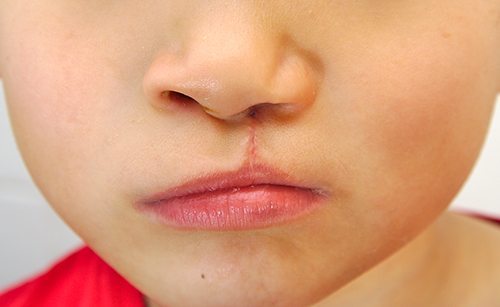Around 1 in 700 babies are born with a cleft palate which nowadays is a fairly simple procedure to correct. A cleft is a hole or gap affecting the tissues in the palate (roof of the mouth) of varying sizes from a small hole to a full-size cleft that spans from the front of the mouth to the back. Children with clefts should be thought of as, with few exceptions, normal children who happen to have been born with a birth defect. Cleft palate is among the most treatable birth defects in the country.
How the Cleft is formed
These clefts are formed during the early stages of pregnancy when the baby’s neck and head are being formed. It is unknown why the 2 halves of the palate do not join together but it is generally thought to be a mixture of genetic and environmental issues. There are around 100 syndromes that can also feature cleft palate, your doctor will examine the child for other symptoms.
The early symptoms of Cleft Palate
It is quite difficult to see the cleft palate on any prenatal scans so is not usually diagnosed until after the child is born during the routine check-up. For a small number of babies the cleft is not immediately obvious and will only be noticed if there is a problem with feeding. The cleft in the baby’s palate will mean that they will find it difficult to form a seal around the bottle or breast, special bottles are available to solve this problem.
Another ailment that can affect children with cleft palate is commonly known as glue ear or otitis media with effusion. Mild to moderate hearing loss occurs as the middle ear gets filled with a sticky fluid.
Treatment for cleft palate
Initial cleft palate repair surgery is ideally performed when the baby is between 9 months and a year old. Surgery involves moving tissue from the edges of the cleft into the cleft area. It is rare that tissue is needed from elsewhere in the body to close a cleft. Further surgery may be required such as pharyngoplasty and buccinator flap surgery both of which improve the function of the soft palate at the back of the mouth.
Cleft lip
A cleft lip may be just a small notch in the lip. It may also be a complete split in the lip that goes all the way to the base of the nose.
For cleft lip surgery, your child will have general anesthesia (asleep and not feeling pain). The surgeon will trim the tissues and sew the lip together. The stitches will be very small so that the scar is as small as possible. Most of the stitches will absorb into the tissue as the scar heals, so they will not have to be removed later.
Most times cleft lip repair is done when the child is 6 to 12 weeks old.
Cleft lip repair for adults
There are many adult patients with scarred cleft repairs that took place either in another country or at a time when techniques were not so advanced as they are now. Correctional surgery and follow-up guidance is available. It is typically possible to improve scarring following cleft lip repair. The correct choice requires an examination of the scar and determination of what troubles you about the scar. Treatments range from injections to soften the scar tissue, resurfacing to smooth it or surgery to remove the scar and replace it with a surgical scar.
Cleft palate in adults
There may have been any number of reasons why cleft palate was not treated as an infant but these should not stop treatment being an option as an adult.
Cleft palate surgical techniques have improved dramatically since older adults were initially diagnosed and follow-up care such as speech therapy are now commonly available.
After the surgery
The patient will continue to be monitored throughout the childhood and teenage years but there are very few long-term adverse effects. Further support such as speech training or orthodontics may be needed depending on each individual case, your specialist will advise on this and any other matters you are concerned with.
Specially trained surgeons
A specially trained cleft surgeon typically should repair a cleft palate. This may be a surgeon who is also trained as a plastic surgeon or paediatric otolaryngologist (ear, nose and throat surgeon) or other training prior to cleft and craniofacial training, including maxillofacial surgeons. More important than surgical speciality is the training and expertise and experience of the surgeon.
About our surgeons
Martin Rees and Tristan De Chalain are two of New Zealand’s most experienced and comprehensively trained Plastic, Reconstructive and Cosmetic surgeons, having between them over fifty years experience and numerous awards in their speciality. Dealing with everything from complex facial restoration to skin cancer treatment and free reconstructive treatment to underprivileged children.
For any advice on this or any other surgical procedure then please feel free to contact us on 09 522 0652 or look at the website for details of your nearest surgery for a consultation.
For any advice on this or any other cosmetic procedure then please feel free to contact us on 09 522 0652 or find details of your nearest Plastic Surgical Centre for a consultation.


